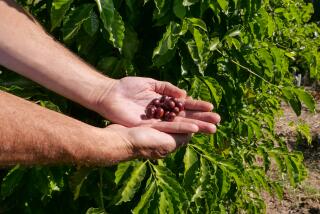As climate changes, coffee farmers struggle to protect crops
- Share via
Reporting from Santa Maria de Dota, Costa Rica — A mile above this rural mountain town, coffee trees have produced some of the world’s best arabica beans for more than a century.
Now, farmers are planting even higher — at nearly 7,000 feet — thanks to warmer temperatures.
“We noticed about six years ago, the weather changed,” said Ricardo Calderon Madrigal, whose family harvests ripe, red coffee cherries at the higher elevation. He sells beans to some of the most notable coffeehouses in the U.S., including Stumptown Coffee Roasters of Portland, Ore., and Ritual Coffee Roasters in San Francisco.
Standing among healthy coffee trees near the upper reaches of his farm, Calderon said he knows he is lucky.
Calderon is one of the few Costa Rican coffee farmers benefiting from the shifting weather pattern, while most of his fellow growers have found themselves on the losing end.
Yields in Costa Rica have dropped dramatically in the last decade, with farmers and scientists blaming climate change for a significant portion of the troubles.
Many long-established plantation owners have seen trees wither or flower too early. Some have given up. Others are trying to outwit changes in temperature, wind and rain with new farming techniques and hardier tree varieties.
Like many tropical crops, coffee cannot tolerate extreme high and low temperatures, and it needs dry and wet seasons. Costa Rica and other countries, such as Colombia, with sophisticated coffee farms and mills, appear to be noticing the effect of climate change first.
These problems are helping to push up the price of a latte or espresso at coffee shops everywhere.
Most important, the fate of coffee in Costa Rica could be a bellwether for food production — and prices — globally, as farmers around the world cope with mudslides, droughts and creeping changes in temperature.
Almost all coffee grows in the tropics, and in general, tropical species are more sensitive to climate change, said Joshua Tewksbury, the Walker professor of natural history at the University of Washington. There are more species there, they can withstand only a narrow band of temperatures and they are not likely to adapt well to change.
Heavy rains in Colombia recently helped drive coffee beans to prices not seen in more than a decade, and coffee companies are watching closely. Last fall, Starbucks raised prices on some drinks to offset rising costs on commodities, notably coffee.
Global warming — more accurately called climate change — poses “a direct business threat to our company,” Starbucks executive Jim Hanna told an Environmental Protection Agency panel in 2009 in Seattle.
Near the crest of a hill on a farm named La Edda for his mother, Francisco Flores bends a knee to touch the curled, yellowed leaves of a young coffee tree, one of hundreds on a windswept ridge where coffee grew strong two decades ago.
“They live, but they don’t produce,” Flores said. “I have an ache in my heart. It’s very difficult to see coffee businesses that went from generation to generation to generation, closing.”
Costa Rica has 25% fewer acres planted with coffee trees than it did a decade ago, according to the national coffee agency ICafe. Roughly 10,000 farmers have quit coffee, some converting their land to pasture for cattle or dairy businesses.
The remaining coffee farms produce less, with yields down 26% in a decade.
Weather is only one problem. Costa Rica also has too many old coffee trees, and farmers’ costs have risen because of a labor shortage and devalued currency.
Still, climate change represents about a quarter of the problem and is expected to worsen, said Ronald Peters, executive director of ICafe.
Experts are trying to help coffee farmers with the problem.
Mostly, they recommend farmers do more of what they have been advising for years to protect the environment and grow better coffee, such as adding shade trees and planting in curved and terraced rows to prevent massive water runoff.
“Farmers are scared,” said Orlando Mora, an agronomist at Starbucks’ farmer support center in Costa Rica. “They are having to alter their daily routines a lot.”
Roberto Mata, who runs the Coopedota cooperative in Santa Maria de Dota that sells to Starbucks, worries about all of it.
“If coffee falls to 100 cents a pound, we won’t survive. We will disappear,” Mata said. Coffee currently sells on the commodities market for about $2.75 a pound.
“Some people do not know what we are suffering,” Mata said. “They can go shopping and buy a bunch of items and throw them all away, and they can sit in their cars for six hours and think it’s not affecting anybody. It’s affecting somebody.”
Allison writes for the Seattle Times/McClatchy.
More to Read
Inside the business of entertainment
The Wide Shot brings you news, analysis and insights on everything from streaming wars to production — and what it all means for the future.
You may occasionally receive promotional content from the Los Angeles Times.










